Specifications:
Displacement 1,533 t.
Length 221' 6"
Beam 47'
Draft 10'
Speed 10 kts
Complement 181
Armament
| Click On Image For Full Size Image |
Size | Image Description | Contributed By |
|
|---|---|---|---|---|
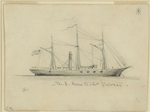
098606001 |
524k | Drawing by Alfred R. Waud from the J.P. Morgan Collection.
|
John Spivey | |
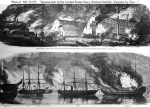 |
115k | "Destruction of the United States Navy-Yard at Norfolk, Virginia, by Fire, by the United States Troops, on April 20, 1861" A line engraving published in "Harper's Weekly", 1861, providing two scenes of the burning of Norfolk Navy Yard and the destruction of ships located there. Ships shown in the lower scene (as identified below the print), from left to right:
USS United States (afire);
tug Yankee with
USS Cumberland (underway, leaving the area);
USS Merrimack (afire in left center distance);
USS Pawnee (underway, leaving the area), and
USS Pennsylvania (afire).
US Naval History and Heritage Command Photo # NH 59179 |
US Naval History and Heritage Command | |
 |
203k | The attack upon the batteries at the entrance of Aquia Creek, Potomac River, by the United States vessels
USS Pawnee,
USS Yankee,
USS Thomas Freeborn,
USS Anacostia, and
USS Resolute, June 1st, 1861.
On May 31st Captain Ward, in command on board of the Thomas Freeborn, and assisted by two more of his
gunboats, the Resolute and the Anacostia, began the attack on the Confederate batteries, and after a two hours' fight, succeeded in silencing
the batteries at the landing; but, for want of long-range ammunition, could not effectually respond to the heavy fire from the heights, and so had to withdraw. The
following day, however, with additional aid from the Pawnee and Yankee, the attack was resumed, and the batteries were at last silenced and the
Confederates compelled to retreat."— Frank Leslie, 1896. US Navy photo # HN 73736 of an engraving from Frank Leslie's Illustrated Newspaper, 1861. |
Tommy Trampp | |
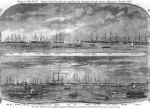 |
223k | "The Great Expedition -- The Vessels at Anchor at Hampton Roads Previous to the Departure". Line engraving published in Harper's Weekly,
July-December 1861 volume, page 725. It consists of two views of Flag Officer DuPont's squadron at Hampton Roads, VA., prior to leaving, 29 October 1861 to capture Port Royal, S.C.
Ships and geographical features, as identified below the images, are (upper engraving, from left to right):
ferry boats, store ship, steamer SS Marion, USS Seminole, steamer SS Ben Deford, tug Grapeshot, Fort Monroe, USS Narragansett, USS Alabama, USS Pawnee, and new ("90-Day") gunboats. (lower engraving, from left to right): store ship, SS Vanderbilt, steam tug (foreground), store ship, steamer Winfield Scott, steamer Atlantic, USS Minnesota, steamer SS Baltic, USS Relief, USS Wabash, USS R.B. Forbes, steamer SS Oriental, steamer SS Matanzas, steamer SS Philadelphia, and the Rip Raps. US Naval History and Heritage Command Photo #: NH 59317 |
Robert Hurst | |
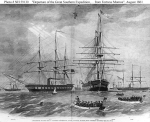 |
146k | "Departure of the Great Southern Expedition, under General Butler, from Fortress Monroe". Line engraving published in "Harper's Weekly", 1861".
depicting the departure of the fleet, 26 August 1861, en route to attack Hatteras Inlet, North Carolina. Ships identified in the title line are (left to right):
USS Harriet Lane; USS Wabash; USS Minnesota; USS Monticello and USS Pawnee and Courtesy of the U.S. Navy Art Collection, Washington, D.C. US Naval History and Heritage Command Photo # 58130 |
US Naval History and Heritage Command | |
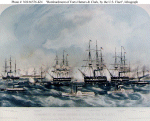 |
93k | "Bombardment of Forts Hatteras & Clark, by the U.S. Fleet"
"Under the command of Flag Officer Silas H. Stringham, on the 28th and 29th of August 1861" A colored lithograph by J.P. Newell after a drawing by Francis Garland,
Seaman in USF Cumberland, published by J.H. Buford, Boston, Massachusetts, 1862.
Features identified below the image are (from left to right):
USS Susquehanna; tug Fanny; Fort Hatteras; USS Harriet Lane; Fort Clark; USS Cumberland; steamer Adelaide; USS Minnesota; steamer George Peabody; USS Wabash; USS Pawnee; and USS Monticello. Courtesy of the U.S. Navy Art Collection, Washington, D.C. US Naval History and Heritage Command Photo # 66576-KN (Color) |
US Naval History and Heritage Command | |
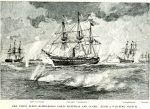 |
522k | USS Minnesota (center), USS Susquehanna, USS Pawnee and other Union warships bombard Confederate forts during the Battle of Hatteras Inlet Batteries. Image from the book 'Battles and Leaders of the Civil War, p.667, being for the most part contributions by Union and Confederate officers, based upon the Century War Series, volume 1, by Robert Underwood Johnson and Clarence Clough Buel. Image courtesy of the British Library from its Digital Collection. |
Robert Hurst | |
 |
78k | "Army & Navy Reconnaissance. Tuesday Morning Nov. 5" 1861
Line engraving published in "The Soldier in Our Civil War", Volume I, page 189, depicting Federal ships investigating Port Royal Sound, South Carolina, prior to their successful attack on Confederate fortifications there.
Ships and other items identified across the bottom of the print include (from left to right): USS Mercury, with Generals Sherman and Stevens & staff on board; USS Penguin, with Hilton Head Battery beyond; USS Pawnee; Broad River (in distance); CSS Huntress (distance); USS Seneca; Steamer Screamer (distance); USS Ottawa with Capt. Rogers & General Wright on board; Steamer Everglades (distance, beyond Ottawa; USS Pembina; CSS Lady Davis (distance); Beaufort River (distance); Bay Point Battery (distance); USS Curlew; (probably misidentified as no record exists that USS Curlew served with South Atlantic Blockading Squadron) Confederate camp (distance); USS Isaac Smith. US Navy photo # NH 59319 |
Tommy Trampp | |
 |
75k | "Bombardment and Capture of Port Royal, South Carolina, 7 November 1861"
Engraving published in "Harper's Weekly", July-December 1861 volume, pages 760-761.
It depicts Federal warships, under Flag Officer Samuel F. DuPont, USN, bombarding Fort Beauregard (at right) and Fort Walker (at left). The Confederate squadron commanded by Commodore Josiah Tattnall is in the left center distance.
Subjects identified below the image bottom are (from left):
tug Mercury, Fort Walker, USS Wabash (DuPont's flagship), steamer Screamer (?), USS Susquehanna, CSS Huntsville, Commo. Tattnall, (probably misidentified as no record exists that CSS Huntsville served in the defenses of Port Royal, S.C. USS Bienville, USS Pembina, USS Seneca, USS Ottawa, USS Unadilla, USS Pawnee, USS Mohican, USS Isaac Smith, USS Curlew; (probably misidentified as no record exists that USS Curlew served with South Atlantic Blockading Squadron), USS Vandalia, USS Penguin, USS Pocahontas, USS Seminole, Fort Beauregard, USS R.B. Forbes and "Rebel Camp". US Navy photo # NH 59256 |
US Naval History and Heritage Command | |
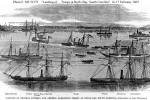 |
149k | "Landing of General Potter's and Admiral Dahlgren's Troops at Bull's Bay, South Carolina". Line engraving, based on a sketch by John
Everding, published in "Harper's Weekly", March 1865, depicting the landings made on 16-17 February 1865. Ships shown include (as identified below the print, from
left to right: USS State of Georgia, USS Pawnee, USS Juniata, USS Harvest Moon--flagship, USS Wando, USS Winona, USS Shenandoah, and USS Canandaigua. US Naval Historical Center Photograph. Photo #: NH 59175 |
Robert Hurst | |

098606009 |
86k | Wood engraving of The War in South Carolina. Action at Legareville. The rebel battery attacking Marblehead silenced and captured, 25 December 1863. From a sketch by our special artist, W.T. Crane. Page 283, USS Marblehead; mortar schooner C. P. Williams; USS Pawnee Illustration for Frank Leslie's Illustrated Newspaper, 23 January 1864. Frank Leslie's Illustrated Newspaper, New York, N. Y.
|
Robert Hurst | |
 |
85k | USS Pawnee at anchor off Charleston, South Carolina, circa 1864-1865. Her bow is fitted with what appears to be a spar torpedo. Artwork or heavily-retouched photo by the Photo Engraving Company, New York. US Naval History and Heritage Command photo # NH 45362-A. |
Robert Hurst | |
 |
118k | View on deck of USS Pawnee looking aft from the forecastle, circa 1863-1864.
An "Old Salt" is standing by the ship's 100-pounder Parrott rifle, with the starboard battery of nine-inch Dahlgren shell guns visible beyond.
Note awnings spread overhead, and crewmen sitting on the deck amidships. Photo courtesy of "Civil War Times Illustrated" magazine.
US Naval History and Heritage Command photo # NH 90536. |
Bill Gonyo | |
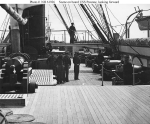 |
138k | View on deck of USS Pawnee looking forward from near the mizzen mast, while the ship was stationed in Charleston harbor, South Carolina, circa 1864-1865. Guns visible include an Army Model 1841 eight-inch siege howitzer (left foreground) and the ship's starboard battery of nine-inch Dahlgren shell guns. Note Sailors on deck and on watch (with telescope) on the bridge, gratings atop hatches, coiled lines, and mechanism for hoisting and lowering the smokestack. Photo courtesy of the Library of Congress US Naval History and Heritage Command photo # NH 61926. |
US Naval History and Heritage Command | |
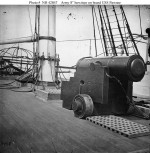 |
118k | US Army 8-inch Siege Howitzer, Model of 1841 on the quarterdeck of USS Pawnee while she was off Charleston, South Carolina,
circa 1864-1865. This howitzer is probably one of two captured by Pawnee and other ships at Legareville, S.C., on 25 December 1863. In 2003 both weapons
were on display at the Washington Navy Yard, D.C. Note grating on deck in front of the howitzer and atop hatches, and belaying pins around Pawnee's mizzen mast. US Naval History and Heritage Command photo # NH 42867. |
US Naval History and Heritage Command | |
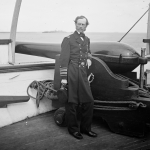 |
213k | Rear Admiral John A. Dahlgren, USN, Commanding the South Atlantic Blockading Squadron is standing beside a 50-pounder Dahlgren rifled gun on board USS Pawnee, in Charleston Harbor, South Carolina, circa 1863-1865. Photo courtesy of the Library of Congress |
Bill Gonyo | |
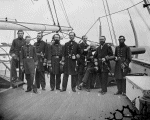 |
217k | RADM. John A. Dahlgren poses with his staff aboard USS Pawnee, in Charleston Harbor, S.C. circa 1864-1865.
From left to right: 1.) Ensign. Ernest J. Dichman, aide 2.) LCDR. Edmund Orville Matthews, Flag Lieutenant Commander 3.) Fleet Paymaster James H. Watmough 4.) Unknown 5.) RADM. John A. Dahlgren 6-9) Unknown Mathew Brady photograph No. B-64, courtesy of the Library of Congress |
Photo - Bill Gonyo Description - LCOL. Steve Glazer USA (Ret.) |
|
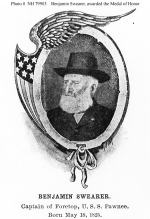 |
107k | Halftone image of Benjamin Swearer, former Seaman, USN USS Pawnee published in "Deeds of Valor", Volume II, page 7, by the Perrien-Keydel Company, Detroit, 1907. Seaman Swearer was awarded the Medal of Honor for "gallant service" during the capture of Fort Clark, North Carolina, on 29 August 1861. He was a member of USS Pawnee's crew at that time. US Naval History and Heritage Command photo # NH 79903. |
US Naval History and Heritage Command | |
 |
338k | The hand carved gangway headboards from the steam sloop-of-war USS Pawnee. Named for the people of the Pawnee Nation, the ship was a pre-war shallow draft steamer built specifically for littoral duties. Heavily armed and well designed, she saw frequent service during the war on both the North Atlantic and South Atlantic Blockading Squadrons. Most notably, she rescued USS Cumberland from the Gosport Navy Yard at the beginning of the war and served in the Port Royal Expedition. After the war, she was based in Hampton Roads and served as a hospital ship. As the name suggests, gangway headboards would be found at the top of a ship's gangway, greeting the ship's company and visitors alike to the ship. Hand carved from a tropical hardwood such as teak or mahogany, the artist would typically create an image that was in line with the ship's name. In this case, the artist chose a Pawnee warrior on one side and his weapons on the other. | Bill Gonyo | |
USS Pawnee (I)
Dictionary of American Naval Fighting Ships (DANFS)
| Back To The Navsource Photo Archives Main Page | Back To The Old Navy" Steam and Sail Index |
| Comments, Suggestions, E-mail Webmaster. |
|
This page is created by Gary P. Priolo and maintained by Michael Junge |